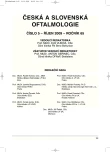Comparison of the Threshold Interpolation and Whole-line Method on logMAR Chart and Snellen Chart for Visual Acuity Testing
Authors:
P. Veselý; J. Ventruba
Authors‘ workplace:
Klinika nemocí očních a optometrie LF MU a FN u sv. Anny, Brno, přednosta doc. MUDr. S. Synek, CSc.
Published in:
Čes. a slov. Oftal., 65, 2009, No. 5, p. 191-194
Overview
The main goal of our study was to prove the statistical significant difference between the threshold interpolation logMAR method on ETDRS chart and the whole-line method on Snellen chart with Sloan letters. We had 108 measurements with the threshold interpolation method and the whole-line method on ETDRS chart and the whole-line method on Snellen chart. The average value measured with the threshold method in ETDRS was 1,132 (min. 0,660, max. 1,580), with the whole-line method on ETDRS it was 1,134 (min. 0,630, max. 1,580) and with the whole-line method on Snellen chart it was 1,183 (min. 0,630, max. 1,600). We have proved statistical significant difference between the threshold interpolation method made on ETDRS chart and the whole-line method made on Snellen chart (p < 0.001). The values measured with the whole-line method on Snellen chart were overvalued. The exact and reliable measuring of visual acuity is an important component of further examinations (e.g. contrast sensitivity, perimetry, tonometry), which enable us to make a correct diagnosis of pathological changes on human eye structures.
Key words:
visual acuity, threshold interpolation method, whole-line method, logMAR ETDRS chart, Snellen chart, letters of Sloan
Sources
1. Bailey, I., Lovie, J.: New design principles for visual acuity letter charts. Am J Optom Physiol Opt, 53, 1976: 740–745
2. Camparini, M., Cassinari, P., Ferringo, L., et al.: ETDRS-Fast: Implementing Psychophysical Adaptive Methods to Standardized Visual Acuity Measurement with ETDRS Charts. Investigative Ophthalmology and Visual Science, 42, 2001: 1226–1231
3. Falkenstein, I., Cochran, D., Azen, S.: Comparison of Visual Acuity in Macular Degeneration Patients Measured with Snellen and Early Treatment Diabetic Retinopathy Study Charts. Ophthalmology, 115, 2008, 2: 319–323
4. Ferris, F., Kassoff, A., Bresnick et al.: New visual acuity charts for clinical research. Am J Ophthalmol, 94, 1982: 91–96
5. Moutray, T., N.: Change of Visual Acuity Recording Methods in Clinical Studies across the Years. Ophthalmologica, 222, 2008, 3: 173–177
6. Peregrin, J. a kol.: Měření a hodnocení zrakové ostrosti, Česká a slovenská oftalmologie , 43, 1987, 3: 73–87
7. Peregrin, J. a kol.: Variabilita vízu, Česká a slovenská oftalmologie, 50, 1994, 1: 18–23
8. Peregrin, J., Svěrák, J.: Statistické hodnocení zrakové ostrosti, Česká a slovenská oftalmologie, 45, 1989, 2: 122–125
9. Rosser, D., Laidlaw, D., Murdoch, I.: The development of a „reduced logMAR“ visual acuity chart for use in routine clinical practice. British Journal of Ophthalmology, 85, 2001: 432–436
10. Rosser, D., Murdoch, I., Fizke, F.: Improving on ETDRS acuities: design and results for a computerised thresholding device. Nature-Eye, 17, 2003: 701–706
11. Siderov, J., Tiu, A.: Variability of measurements of visual acuity in a large eye clinic. Acta Ophthalmol Scand, 77, 1999: 673–676
12. Synek, S.: Optika, refrakce oka a její vady. 111 – 129. In: Rozsíval, P. Oční lékařství. Galén, Praha, 2006, 363 s.
13. Ventruba, J.: Psychofyzikální vyšetřovací metody a subjektivní hodnocení zrakových funkcí u pacientů před a po operaci katarakty. Disertační práce. Brno, LF MU, 2005: 90
14. Veselý, P.: Testování zrakové ostrosti prahovou interpolační metodou logMÚR ETDRS. Česká oční optika, 49, 2008, 2: 12–14
Labels
OphthalmologyArticle was published in
Czech and Slovak Ophthalmology

2009 Issue 5
Most read in this issue
- Diagnosing of Acanthamoeba Keratitis
- Current Therapeutic Approach in Non-infectious Uveitis
- Benefit of the Surgical Treatment of the Idiopathic Intracranial Hypertension – a Case Report
- Contrast Sensitivity and Higher Order Aberration after Conventional LASIK Treatment
